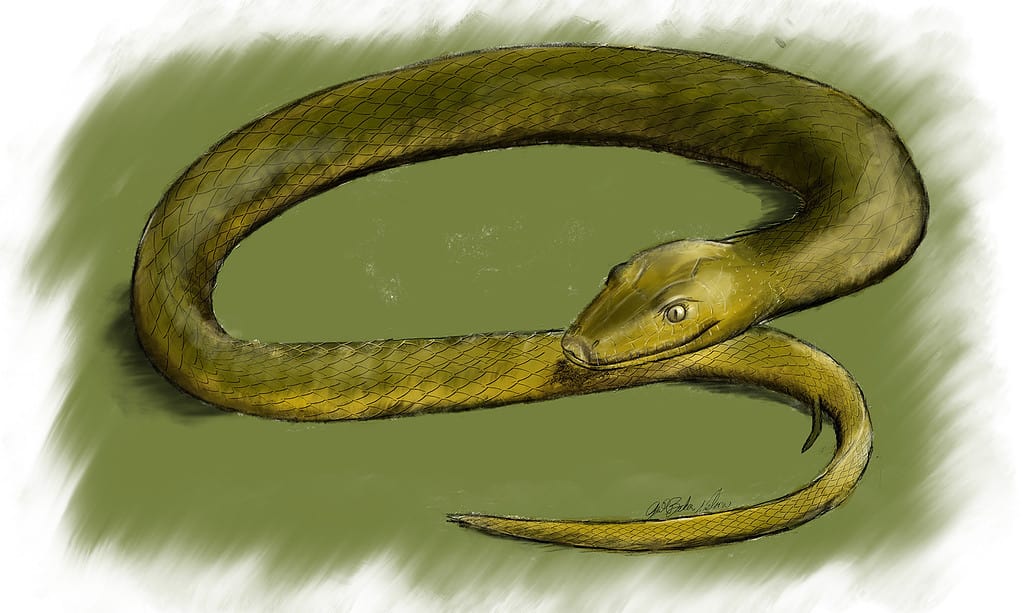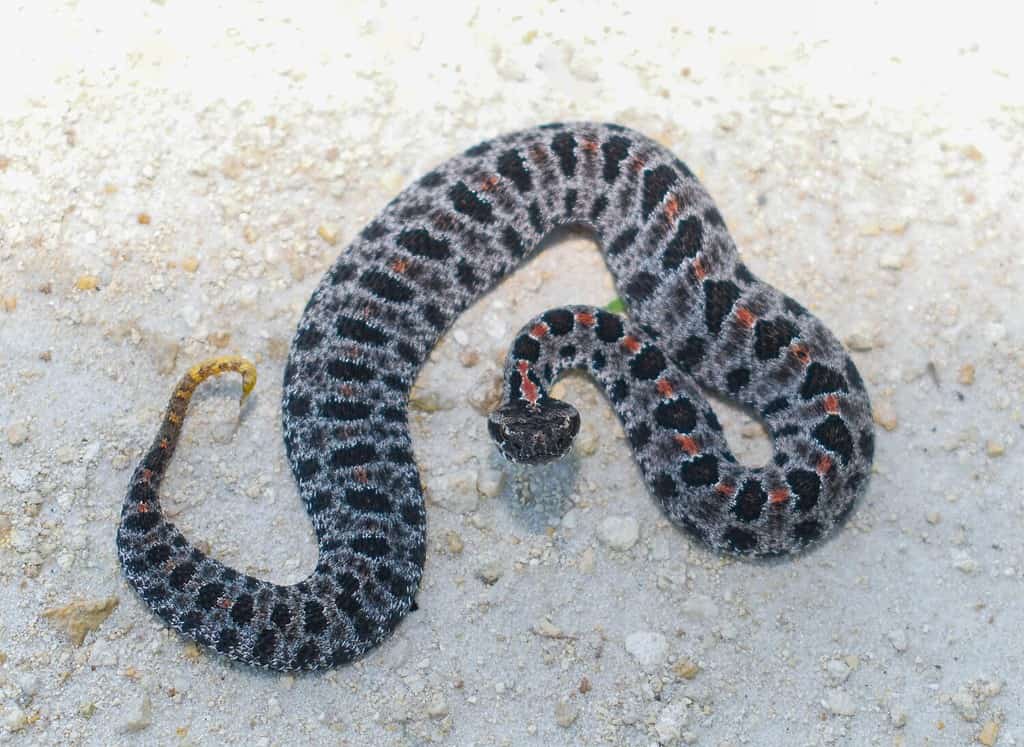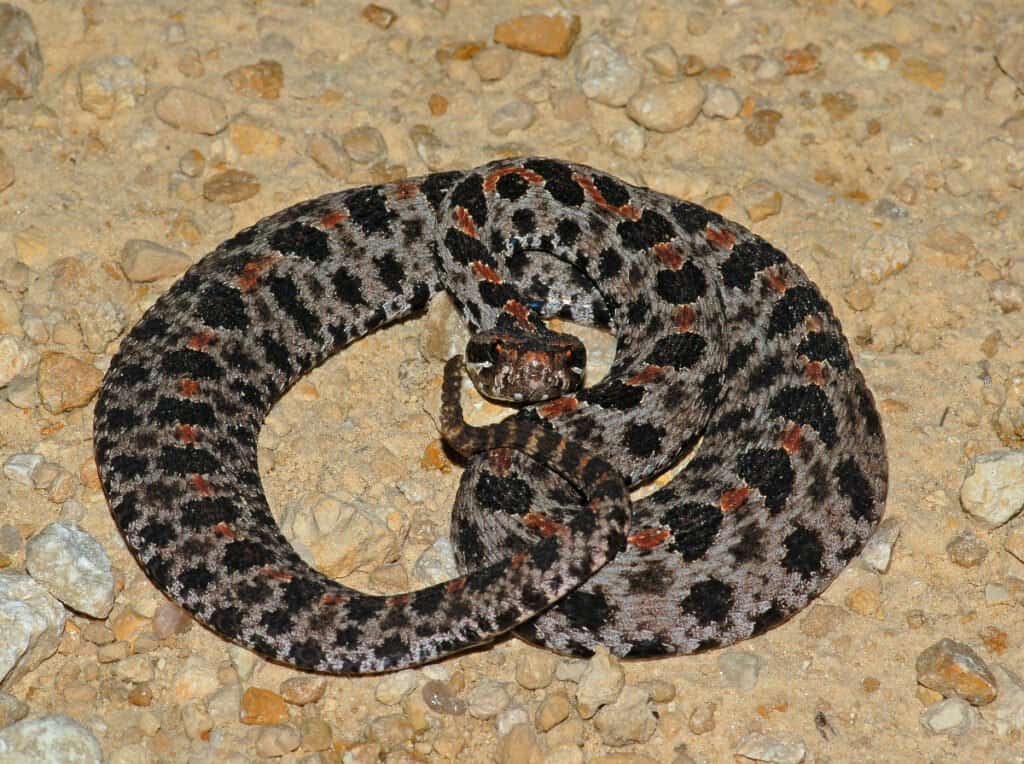Pygmy Rattlesnake
miliarius
Pygmy rattlesnakes’ rattle is so small it can only be heard from about three feet away.
Advertisement
Pygmy Rattlesnake Facts
- Prey
- Invertebrates, lizards, frogs, mice, small rats, smaller snakes.
- Name Of Young
- Neonates, snakelets
- Group Behavior
- Solitary
- Solitary except during mating season
- Fun Fact
- Pygmy rattlesnakes’ rattle is so small it can only be heard from about three feet away.
- Biggest Threat
- Habitat loss, people who kill them out of fear.
- Most Distinctive Feature
- Tiny rattle, orange-red dorsal stripe.
- Other Name(s)
- Carolina pygmy rattler, miliary rattler, little rattlesnake, dusky pygmy rattlesnake, Oak-leaf rattler,
- Gestation Period
- About three months
- Age Of Independence
- Several days after birth
- Litter Size
- 1-14
- Lifestyle
- Nocturnal
- Crepuscular
- Number Of Species
- 3
View all of the Pygmy Rattlesnake images!
The pygmy rattlesnake is no more than 32 inches long and lives in wetter areas than other rattlesnakes prefer.
In the swamps and marshy lowlands of the southeastern United States lives one of the smallest rattlesnake species in the world. The pygmy rattlesnake’s high-pitched buzzing rattle is one of the most distinctive things about it.
Pygmy Rattlesnake Amazing Facts
- One of the smallest rattlesnake species, pygmy rattlesnakes are usually only about two feet long.
- This species only lives in the southeastern United States and has a tiny rattle.
- Some sources describe them as particularly feisty, but studies show they’re reluctant to bite.
Where to Find Pygmy Rattlesnakes
These snakes are endemic to the United States and found only in the states of Alabama, Arkansas, Florida, Georgia, Kentucky, Louisiana, Missouri, Mississippi, North Carolina, South Carolina, Tennessee, and Texas. Scientists currently accept three subspecies, including the nominate subspecies, and each has its own range.
Pygmy rattlesnakes inhabit marshy, wet areas like floodplains, wet savannas and pastures, palmetto-pine flatwoods, swamps, the edges of cypress ponds, and roadside ditches. This species and the others in the Sistrurus genus are much more fond of wet habitats than any rattlesnakes in the Crotalus genus.
They take shelter under surface cover, like logs, thickets, and animal burrows. Like other snakes, it’s a great swimmer, but only rarely do they climb.
Pygmy Rattlesnake Scientific Name
Unlike nearly all other rattlesnakes, pygmy rattlesnakes are not in the Crotalus genus. Instead, pygmy rattlesnakes are in the Sistrusus genus; their scientific name is Sistrurus miliarius.
Scientific names use ancient Greek and Latin because they’re not actively spoken anymore, so they don’t change the way modern, living languages change. For pygmy rattlesnakes’ scientific name, scientists chose Sistrurus, a Latinized version of the Greek word for “tail rattler.” It also shares the same root as the ancient Egyptian instrument, the sistrum, which is a type of small rattle.
Depending on where it lives and which subspecies it is, pygmy rattlesnakes go by several different common names. However, its common name of pygmy rattlesnake isn’t because of the snake’s size but because of its rattle, which is very small.
- Ground rattlesnake
- Little rattlesnake
- Miliary rattlesnake
- Oak-leaf rattler
- Spotted rattler
- North American smaller rattlesnake
- Southern rattlesnake
- Carolina pygmy rattlesnake
- Dusky pygmy rattlesnake
Types of Pygmy Rattlesnakes
There are three currently accepted pygmy rattlesnake subspecies. They are widely distributed across the southeastern United States, and each subspecies lives in a different region.
- Carolina pygmy rattlesnake (S. m. miliarius) — Extreme southern South Carolina, eastern North Carolina, and west through central Georgia and Alabama.
- Dusky pygmy rattlesnake (S. m. barbouri) — occurs from South Carolina to Florida and southeast Mississippi.
- Western pygmy rattlesnake (S. m. streckeri) — Mississippi, Arkansas, Louisiana, Alabama, Oklahoma, southwest Tennessee, and east Texas.
In addition to the three subspecies, there are two other species within the Sistrurus genus. They’re called Massasaugas, a word that came from the Ojibwe language and means “river mouth.”
- Eastern Massasauga (Sistrurus catenatus) — from Missouri east to New York and north into southern Ontario, Canada.
- Western Massasauga (Sistrurus tergeminus) — from Arizona east to Texas, north to Nebraska, and includes western Missouri and Iowa.
Pygmy Rattlesnake Population and Conservation Status
According to the IUCN Redlist of Threatened Species, pygmy rattlesnakes are a species of Least Concern. But In Texas, Louisiana, Tennessee, North Carolina, and South Carolina, these snakes are either “Imperiled” or “Vulnerable.” Even though there are some areas where the populations are reduced or extirpated, they still inhabit most of their range.
This species inhabits many regional and national parks and appear to have a stable population. However, snakes are notoriously difficult to count accurately for any population census.
How to Identify Pygmy Rattlesnakes: Appearance and Behavior
This small rattlesnake species only measures about two feet long as adults, but they can grow to about two and a half feet long. That’s about the same length as an adult human’s arm, from fingertip to shoulder.
Pygmy rattlesnakes have very small rattles that connect more snugly than those of rattlesnakes in the Crotalus genus. So, they produce a much higher-pitched rattle that sounds more like a buzz than a rattle, and people often overlook it. Just as with their larger cousins, juvenile snakes don’t have a rattle until they’ve shed a few times. Instead, their tail is bright yellow with the beginnings of a rattle called a button.
Pygmy rattlesnakes are thick-bodied for their size and have big heads with thin necks. Unlike Crotalus genus rattlesnakes, these snakes have nine large shield-like scales on their heads.
Individuals of this species usually have a base color of varying shades of gray to yellowish brown or tan, with dark circular or oval dorsal and side spots, and most have an orange or reddish dorsal stripe that’s broken by the dorsal spots. A large dark stripe begins behind the eye and extends toward the back of its lower jaw.
Like other rattlesnakes, pygmy rattlesnakes brumate during the cooler months; for those in Florida and other southern areas, the weather may never get cold enough to trigger a resting period. However, snakes in regions where it does get cold enough for a brumation period eat as much as they can to build up fat and glucose stores. Then, they head off to rest by late October until it warms up again — usually between March and April.
Pygmy Rattlesnake Reproduction, Babies, and Lifespan
There’s little or no sexual dimorphism in this species, but some believe that males may be a little larger than females. In March or April, the males follow pheromone trails left by the females and engage in ritual combat dances to determine mating rights.
Like most pit vipers, pygmy rattlesnakes are ovoviviparous and give birth to 1-14 live young. The females carry the babies for about three months until the babies are ready. After birth, they stay together for a few days until the young have had their first shed before they go their separate ways.
Pygmy rattlesnakes have lived for over 12 years in captivity, but in the wild, they probably don’t live as long.
Predators and Threats: Pygmy Rattlesnake
All rattlesnakes are food for something. Pygmy rattlesnakes are no exception, and their small size makes them a tasty morsel for even more animals. Depending on where they live, pygmy rattlesnakes may be predated by roadrunners, hawks, eagles, owls, coyotes, bobcats, mountain lions, and various snake species.
For pygmy rattlesnakes, prey items can include small frogs, lizards, snakes, small mammals, and sometimes invertebrates. These snakes hunt by ambush. They take advantage of the camouflage their coloration and patterns offer and wait until their meal wanders close enough to strike.
In addition to the “wait-and-strike” approach, pygmy rattlers use their tail to lure prey within striking distance. It’s a behavior called caudal luring that some snake species employ to increase their odds of eating. As they grow, the method becomes less effective because their intended prey is bigger.
Although this species uses its rattle-tended tail as a lure when it’s young, some snakes, like the spider-tailed horned viper, have tails specifically evolved for luring prey.
There aren’t any major threats to its population, but some local areas may have reduced populations because of habitat loss and possibly disease. Between September 1997 and March 1998, scientists observed a small subpopulation suffering from fungal dermatitis and stomatitis, which was severe enough to kill some of the snakes.
Pygmy Rattlesnake Evolution and History
Snake evolution is fascinating and buried in layers of sediment. Fossils are few and far between because these are animals with small, delicate bones. As frightening as snakes can be for people, they’re far more delicate than people realize. At this point in their evolution, snakes are almost all spine, and many only have one fully functional lung and a tail. Some have vestigial legs and pelvises, but most don’t.

Scientists believe snakes evolved from either a burrowing or aquatic lizard, possibly during the Jurassic period. There aren’t many fossils, but the earliest fossils known to science are dated between 167 and 143 million years ago.
The earliest fossil that scientists agree is a snake ancestor is Haasiophis terrasanctus, found in Isreal, dated to approximately 112 to 94 million years old. True variety in snakes didn’t appear in the fossil record for another 77 million years or about 88 to 56 million years ago.
Pygmy Rattlesnake Pictures

Dusky pygmy rattlesnake in full view, showing its yellow tail and reddish dorsal line.
©Chase D’animulls/Shutterstock.com

Pygmy rattlesnakes have small rattles, which is where they get their name.
©Gerald A. DeBoer/Shutterstock.com

Close-up view of red phase Carolina Pigmy or Pygmy rattlesnake – Sistrurus miliarius miliarus – front view of head and face showing heat sensing pits on either side. Georgia North Carolina border.
©Chase D’animulls/Shutterstock.com
Pygmy Rattlesnake Venom: How Dangerous Are They?
Rattlesnakes are pit vipers. All snakes in that group have movable, hinged fangs that attach to venom glands. However, unlike bigger species, pygmy rattlesnakes can’t inject as much venom because they are much smaller than most.
Pygmy rattlesnake venom is devoid of any neurotoxins but causes a lot of tissue damage because it contains hemotoxins that destroy blood cells. Most people recover fully with prompt medical treatment, but a pygmy rattlesnake bite is a medical emergency.
Even though rattlesnake bites are dangerous and can kill with a big enough dose or a bad reaction, medical research finds ways to make rattlesnake venom heal. That research created the blood thinner Eptifibatide came from this snake’s venom and helps reduce cardiac events in some patients.
Pygmy Rattlesnake Behavior and Humans
Although the myths say that these snakes are feisty and aggressive, most scientists dispute that after studying them in the wild. They are fairly reluctant to bite, and sometimes don’t even rattle — not that it would matter unless a person stood within about three feet of a rattling pygmy rattlesnake.
This species isn’t common near neighborhoods, but tend to be more rural in their preferences. That tendency keeps people from encountering them too often. Most of the time, they’re hidden so well that hikers and others walk right past without seeing the small rattler.
Snakes like this are a big part of the ecosystem in a small package. They eat various rodents and other animals that destroy crops and spread disease — keeping the habitat and humans healthier.
Similar Animals
View all 192 animals that start with PPygmy Rattlesnake FAQs (Frequently Asked Questions)
Are pygmy rattlesnakes venomous?
Yes! Their venom is potent, but they’re so small that a fatal dose is hard for them to deliver. Still, they are pit vipers and should be admired from a distance.
What do pygmy rattlesnakes eat?
These tiny predators eat small frogs, lizards, snakes, small rodents, other mammals, and sometimes invertebrates.
Are pygmy rattlesnakes aggressive?
Depends on who you ask. Some snakes are feisty as can be, but most are pretty calm and reluctant to bite.
How do pygmy rattlesnakes hunt?
Mostly by ambush, but young snakes help increase their chances of eating by using their bright yellow tail to lure prey closer.
Where do pygmy rattlesnakes live?
Across the southeastern United States in marshy, wet areas. They’re good swimmers and sometimes live at the edges of cypress swamps.
Thank you for reading! Have some feedback for us? Contact the AZ Animals editorial team.
Sources
- NatureServe Explorer, Available here: https://explorer.natureserve.org/Taxon/ELEMENT_GLOBAL.2.106160/Sistrurus_miliarius
- Hammerson, G.A. 2007. Sistrurus miliarius. The IUCN Red List of Threatened Species 2007: e.T64347A12772862. https://dx.doi.org/10.2305/IUCN.UK.2007.RLTS.T64347A12772862.en., Available here: https://www.iucnredlist.org/species/64347/12772862
- Reptile Database, Available here: https://reptile-database.reptarium.cz/species?genus=Sistrurus&species=miliarius

















